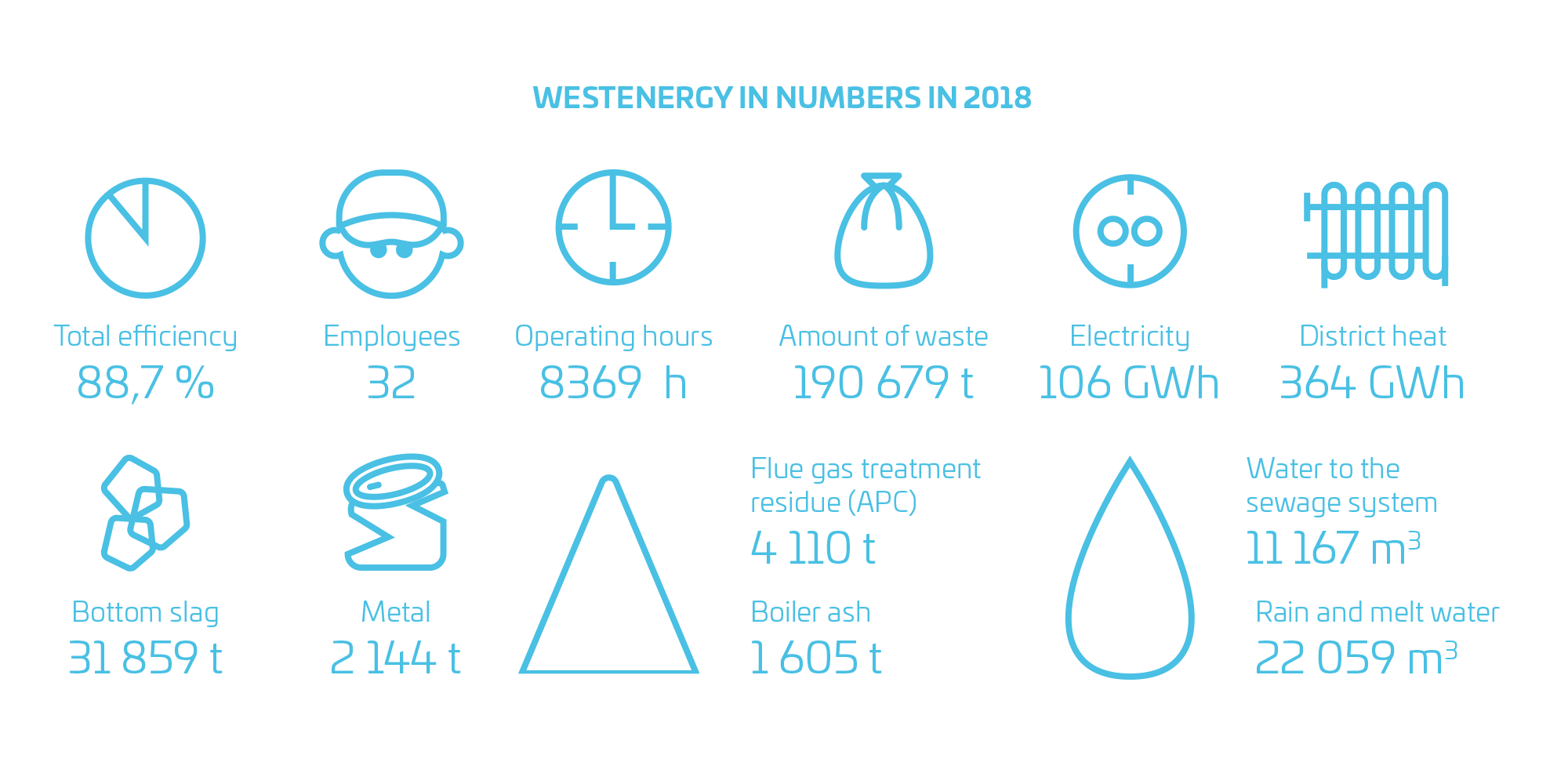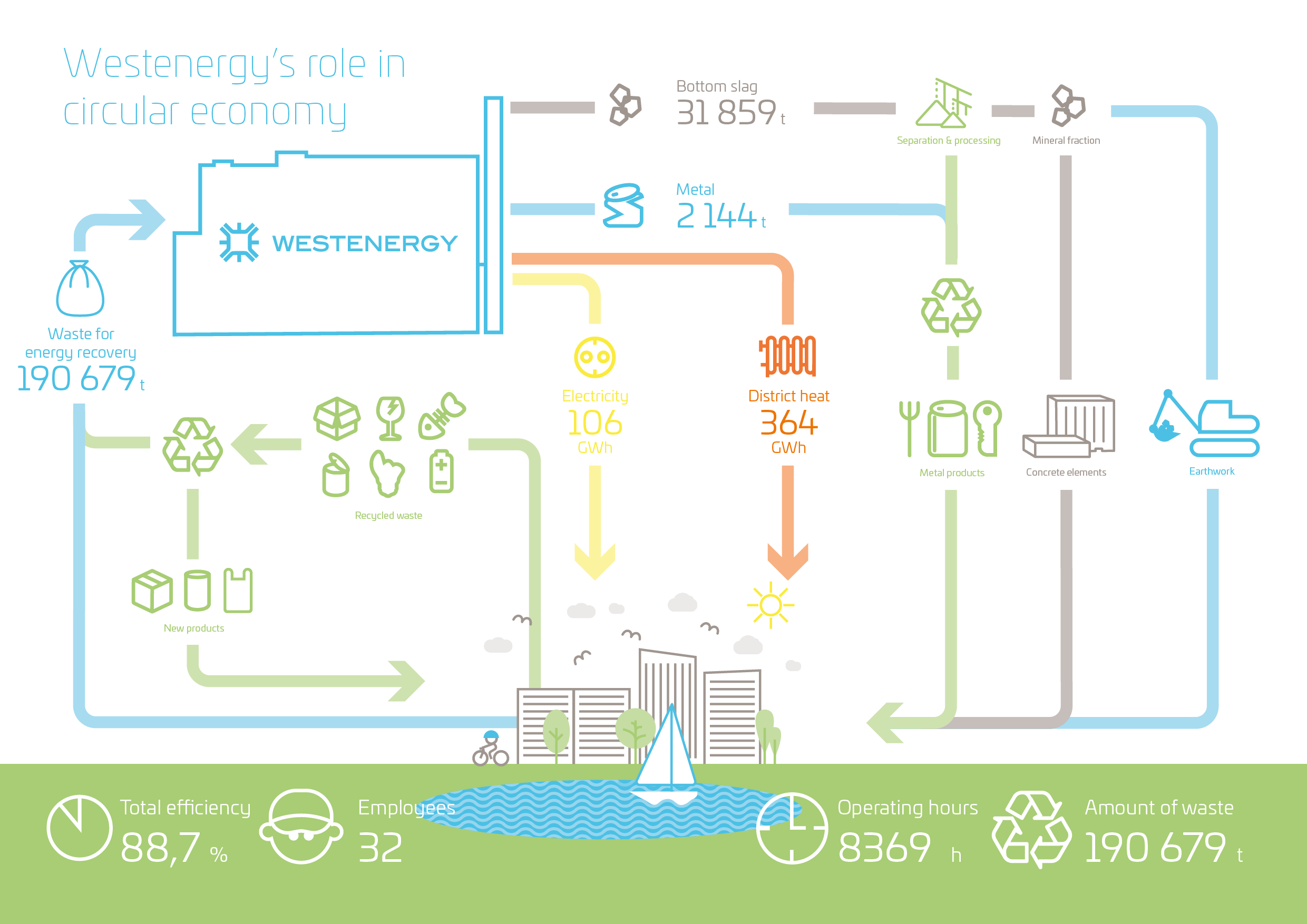


Records in the amount waste and production of district heat
From a productional point of view, year 2018 was a very successful one. 191 000 tonnes of waste was processed in the plant, this being more than in any other year in the plant’s history. The large amount of waste translated into a record also in district heat production: in 2018, 364 gigawatt-hours of district heat was produced in Westenergy’s plant which is over 40 percent of the consumption of district heat in the Vaasa region. In addition, 106 gigawatt-hours of electricity was produced in the plant in 2018 which corresponds to the annual electricity consumption of some 7 000 households.
The plant availability in 2018 was very high, 95,5 %. With the help of the skillful staff, production deviations have been kept at minimum, and malfunction occurred only once in 2018: in April the plant shut down in an island mode due to disturbance in the turbine system. The auxiliary grid could, however, be quickly switched on, and the production deviation remained short, taking only about 30 hours. During the six years of operation, the staff has come to know the plant thoroughly, and this has helped in planning the service stops and outlining the preventive maintenance programmes.
There are several different reasons that can cause the plant to shut down so in this sense, a single production line is relatively vulnerable. One major challenge for the plant operation is poor waste quality as it can cause problems both in energy production and in flue gases. In the summer and at the end of the year, exceptionally large metal items ended up to the plant, and they were noticed only when they were already on the grate. Metal is not a suitable material for incineration as there is no energy to recover. In addition, large metal items can get stuck in, for example, the waste feed chute or bottom slag outlet system, and in the worst-case scenario, the plant must be shut down. Removing metal items is challenging and sets special requirements for occupational safety.
The waste bunker of the plant has been planned so that during short service stops, waste can be stored in the bunker. During longer service stops, however, waste deliveries are directed to a nearby storing area. During the longer service stops, the storing area had been filled up with waste and in 2018, a key objective was to empty the storing area. The goal was achieved, and the storing area was emptied at the end of the year. Last year waste was also put up in bales for the first time.
For the plant to operate properly, it is important that fuel is delivered to the plant at a steady pace. The amount of waste that the waste management companies receive, however, varies depending on the time of the year. Despite this, Westenergy’s owner companies have succeeded in regulating and evening out the amount of waste delivered to the plant.
All maintenance and repair work that cannot be carried out when the plant is in operation are carried out during the annual service stop.
Maintenance creates the prerequisites for the WtE plant’s high availability
Regarding maintenance, a central goal is that the annual service stop proceeds as planned and on schedule. In 2018, 16 days were reserved for the service stop but it took 36 hours less than planned. All maintenance and repair work that cannot be carried out when the plant is in operation are carried out during the annual service stop. Last year, for instance, the lime supply system of the plant was improved and now the amount of lime can be adjusted more accurately than before. The lime injection system plays a key role lime is used to neutralise acidic impurities, and of the chemicals used to purify the flue gases, lime is consumed the most.
Planning the next service stop starts as soon as the previous service stop ends, and the to-do list gets longer when the service stop is drawing nearer. The condition of the boiler pipes is checked annually as they are liable to impurities in the flue gases, and acidic impurities cause corrosion in the pipes. The check-up indicated that the boiler pipes are, however, in good condition and abrasion is relatively minor.
In 2018, the turbine’s first overhaul of 50 000 hours was carried out. When the turbine was opened, it was instantly noticed that the rotor of the turbine as well as the rotor and leading blades were in good condition which indicates that the steam quality is high. The super-heated steam led to the turbine is produced from the boiler water, and the turbine overhaul indicated that also the hydrochemistry of the plant is in control. Samples are taken regularly from the boiler water, and there is a special team responsible for monitoring the boiler water quality.
Thousands of different preventive maintenance tasks carried out outside the service stop create the prerequisites for the high availability of the plant. The maintenance tasks are divided into mechanical and electricity / automation tasks, and there is a team for both at the plant.
Flue gas scrubber improves heat recovery and purification
With the flue gas scrubber, Westenergy takes the Vaasa region one step closer to carbon-neutral energy production as the scrubber will increase the capacity to produce district heat by approximately 20 percent. Energy recovery of waste replaces the use of fossil fuels such as coal and fuel oil which means that carbon dioxide emissions in the area will decrease.
The flue gas scrubber will be installed after the current flue gas purification system. Currently the flue gases of the plant are led out of the stack at 140 degrees Celsius but after the scrubber has been installed, the temperature will drop to approximately 50 – 60 degrees Celsius. Using the scrubber forms condensation water which will be purified and used primarily in plant processes. The condensation water can also be used as feed water in the district heating system, and any additional purified condensation water is led to the sewage system.
A large-scale district heat expansion is carried out inside the plant, and the automation system will be updated for those parts concerning the flue gas scrubber. As the temperature of the flue gases drops, and the moisture content grows, a new stack will be installed as well.

